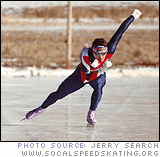2010 Olympics: Speed Skating


The Olympic demolition derby
by Mike Morrison and Christine Frantz
 Dan Jansen Related Links
Memorable MomentsDid You Know?There are two women on the Chinese short-track team with the name Yang Yang. To distinguish them, one goes by Yang Yang (A), while the other goes by Yang Yang (S). |
Short Track
It's been called the demolition derby of the Olympics. In short-track speed skating, competitors squeeze into a tight oval track measuring just 111 meters (364 ft) around. At full speed, they jockey for position and often bump one another. Spills are frequent and sometimes nasty.
Though short-track speed skating dates back to the late 1800's, the sport didn't become an officially recognized Olympic event until the 1992 Albertville Games.
The competition consisted of four events in 1992, but was expanded to eight in 2002:
- 500 meters (men's and women's)
- 1,000 meters (men's and women's)
- 1,500 meters (men's and women's)
- 3,000 meter relay (women's)
- 5,000 meter relay (men's)
In the 500- and 1,000-meter events, four skaters are on the track for each heat, while in the 1,500-meter event there are six skaters on the ice. The thrilling speed skating relay events, unlike running relays, do not involve handing off batons. Instead the athletes are simply given a push by their teammates when it's time to skate.
In the 2006 Games in Torino, Italy, South Korea lead the pack by a wide margin, with six gold medals. The U.S. and China both earned one. American skater Apolo Ohno earned that gold, plus two bronze medals; he is poised to add to his collection of five Olympic medals in the 2010 Games, though J.R. Celski is also a contender for the Americans in short track.
Long Track
The type of speed skating that most Americans are familiar with is the long-track variety. And for that, we have Eric Heiden, Bonnie Blair, and Dan Jansen to thank.
Heiden and Blair are the two most decorated American winter Olympians of all time, Heiden with five golds (all from the 1980 Lake Placid Games) and Blair with five golds and a bronze. And while Jansen may have just one medal to his credit, few could forget his world-record-setting, gold-medal performance in the 1,000-meters in 1998, after falling twice in 1992 on the same day his sister died, then again failing to medal in 1994.
Men's speed skating has been an Olympic sport since the first Winter Games in 1924. Women's speed skating became an official event in 1960 at Squaw Valley.
There are currently ten events in long track:
- 500 meters (men's and women's)
- 1,000 meters (men's and women's)
- 1,500 meters (men's and women's)
- 5,000 meters (men's and women's)
- 3,000 meters (women's)
- 10,000 meters (men's)
Though speed skating can be traced back to England in the mid-1700's, the Netherlands is widely considered the sport's birthplace.
The U.S. took home seven medals in the 2006 Games; three gold, three silver, and a bronze. The golds were captured by Joey Cheek, Shani Davis, and Chad Hedrick; Davis and Hedrick are returning to the competition, and both of whom are expected to have similar performances in Vancouver. Newcomer Trevor Marsicano also shows promise.
Since 1998, when the "clap" skate was officially approved for Olympics competition, speed records have been set at…a record pace. The skate is a technological breakthrough in which the blade actually detaches from the heel of the skate, allowing for it to stay on the ice longer.
